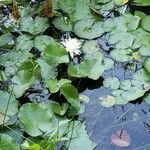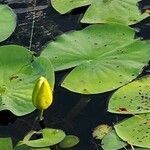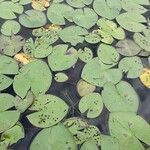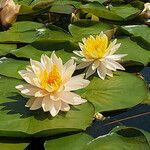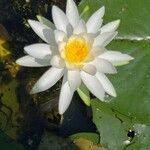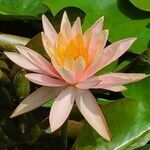Rhizomes frequently branched, repent, cylindric; stolons absent. Leaves: petiole glabrous or pubescent. Leaf blade abaxially green to purple, adaxially green, ovate to nearly orbiculate, (5-)10-40 × (5-)10-40 cm, margins entire; venation radiate centrally, without weblike pattern, principal veins 6-27; surfaces glabrous. Flowers floating, 6-19 cm diam., opening and closing diurnally, only sepals and outermost petals in distinct whorls of 4; sepals uniformly green or reddened, obscurely to prominently veined, lines of insertion on receptacle not prominent; petals (14-)17-43, white, rarely pink; stamens 35-120, yellow, connective appendage projecting less than 1(-2) mm beyond anther; filaments widest below middle, mostly longer than anthers; pistil 10-25-locular, appendages at margin of stigmatic disk linear-tapered, 3-8(-10) mm. Seeds ovoid, ca. 1.5-4.5 × 0.9-3 mm, 1.5-1.75 times as long as broad, lacking papillae on surface.
A waterlily. It grows 10-40 cm high and spreads 0.9-2.4 m wide. One plant can cover 5 squ metres of water area. The leaves float on water. The leaves are green on top and red or purple underneath. The leaves are fairly round. They are 15-20 cm across. The leaves with stalks spread 1-1.2 m wide. The flowers tend to be white. The flowers are 5-11 cm across. It flowers during the day.
